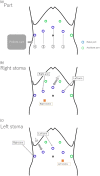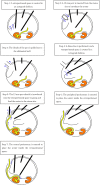Complete retroperitoneal cutaneous ureterostomy with robot-assisted radical cystectomy
- PMID: 38686063
- PMCID: PMC11056249
- DOI: 10.1002/iju5.12717
Complete retroperitoneal cutaneous ureterostomy with robot-assisted radical cystectomy
Abstract
Introduction: Cutaneous ureterostomy is beneficial for older patients in a hypoalimentation state, providing less invasive options than intestinal tract reconstruction techniques. However, complications such as ileus and stoma site hernia still pose risks owing to the anatomical location of the ureter. We introduce a novel method, complete retroperitoneal cutaneous ureterostomy, performed simultaneously with robot-assisted radical cystectomy.
Case presentation: Our technique involves extending the retroperitoneal space to minimize complications and achieve stent-free outcomes. The median procedure time for complete retroperitoneal cutaneous ureterostomy was approximately 30 min. The stent-free rates at 1 and 4 months postoperatively were 66.7% and 100%, respectively; no case of stent reinsertion after stent removal was reported.
Conclusion: Our approach is promising for avoiding postoperative intestinal tract complications.
Keywords: cutaneous ureterostomy; cystectomy; retroperitoneal space; robot‐assisted.
© 2024 The Authors. IJU Case Reports published by John Wiley & Sons Australia, Ltd on behalf of Japanese Urological Association.
Conflict of interest statement
The authors declare no conflict of interest.
Figures



Similar articles
-
Cutaneous ureterostomy following robot-assisted radical cystectomy: a multicenter comparative study of transperitoneal versus retroperitoneal techniques.World J Urol. 2024 Oct 23;42(1):591. doi: 10.1007/s00345-024-05300-x. World J Urol. 2024. PMID: 39441314 Free PMC article.
-
Rare small bowel obstruction: Parastomal hernia of cutaneous ureterostomy after robot-assisted radical cystectomy. Case report.Urol Case Rep. 2021 Jan 11;36:101566. doi: 10.1016/j.eucr.2021.101566. eCollection 2021 May. Urol Case Rep. 2021. PMID: 33489772 Free PMC article.
-
Analysis of the efficacy of a single subumbilical stoma for bilateral cutaneous ureterostomy after radical cystectomy.Eur J Med Res. 2023 Aug 7;28(1):273. doi: 10.1186/s40001-023-01250-z. Eur J Med Res. 2023. PMID: 37550747 Free PMC article.
-
Simultaneous en-bloc robot-assisted radical cystectomy and nephro-ureterectomy: technique description, outcomes, and literature summary.J Robot Surg. 2016 Dec;10(4):315-322. doi: 10.1007/s11701-016-0600-1. Epub 2016 May 6. J Robot Surg. 2016. PMID: 27153839 Review.
-
[Review of complications of urinary diversions performed during a 6-year period in the era of orthotopic neobladders].Arch Esp Urol. 1997 Jun;50(5):433-45. Arch Esp Urol. 1997. PMID: 9382585 Review. Spanish.
Cited by
-
Retroperitoneal cutaneous ureterostomy following radical cystectomy: A multicenter comparative study of robotic versus open surgery.Int J Urol. 2024 Dec;31(12):1408-1413. doi: 10.1111/iju.15580. Epub 2024 Sep 10. Int J Urol. 2024. PMID: 39253871 Free PMC article.
-
Cutaneous ureterostomy following robot-assisted radical cystectomy: a multicenter comparative study of transperitoneal versus retroperitoneal techniques.World J Urol. 2024 Oct 23;42(1):591. doi: 10.1007/s00345-024-05300-x. World J Urol. 2024. PMID: 39441314 Free PMC article.
References
-
- Mottet N, Ribal MJ, Boyle H et al. Management of bladder cancer in older patients: position paper of a SIOG task force. J. Geriatr. Oncol. 2020; 11: 1043–1053. - PubMed
-
- Chikaraishi K, Ohkuma M, Kosuge M, Eto K, Yanaga K. A strangulation ileus due to a mobilized ureter after total cystectomy with ureterostomy: a case report. J. Jpn. Coll. Surg. 2019; 44: 1062–1066.
Publication types
LinkOut - more resources
Full Text Sources
